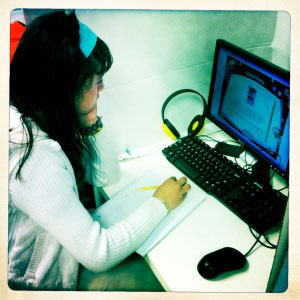It's important to note here that not all assessments are created equal, but Samouha believes that the NWEA is an adaptive diagnostic test and a dependable measure because "millions of kids taken it," he said.
Those students' gains are not only statistically significant, he said, but the fact that they were achieved in such a short time -- 16 weeks -- indicates that using the program for an entire school year would show even greater gains.
But Samouha is not a tech evangelist just for the sake of using tech. "It’s true that there’s a lot of time wasted on computers right now. There are wrong ways of doing this. But it’s so clear that we have to figure out how to educate students in the 21st century in ways that go beyond the traditional classroom model, which was created in the 17th century in Prussia. The fact that it needs to change is not a question in my mind."
So how to make this happen? "The more we integrate software with what’s happening in the classroom, the better results we’ll see. That will take work and investment. Schools will have to invest time, content providers will need to invest time and energy into make it more plug-and-play and make it more integrated into the school day."
But Samouha says the Times article proves the opposite of what the writers end up conveying. "It shouldn't be a call to stop for investment, but a call to invest more, because we need to get it right," he said.
What "right" looks like can be debatable, but Samouha believes he has it nailed down -- at least in the case of elementary schools. His criteria for successful software are:
- Aligned to common standards, "so we're all speaking the same language."
- Data needs to be seamlessly integrated and programs need to be able to talk teach other so teachers can easily make sense of the data.
- Rather than be standalone in their environment, they need to be part of the open Web, so they can be linked to each other. "Right now there are a lot of walls between programs, just like before Steve Jobs agreed to use Microsoft, so people using Macs couldn't open Microsoft programs," he said. "Those walls exist now, if you’re trying to quilt together a number of interventions to put the right thing in front of a child at the right time, it makes it much harder when those walls exist.
That’s what Samouha is working towards. But it won't magically happen. It takes investment from schools, from vendors, from educators. "But we can't just abandon ship and go back to the traditional school model."
At the heart of this discussion for the general public and most major media is the question "why." Why should we bother to invest in all this when we (adults) all turned out just fine with the way we were schooled? Why can't just teachers keep teaching the way they have been?
Samouha believes that's a false dichotomy. He's not arguing that teachers should be replaced by software, but that students will benefit from an array of different learning methods. Software will help them practice drills and basic skills, but teachers will be always be the most important part of the equation.
"People are arguing that it's either human beings teaching kids or computers," he said. "But that’s not our answer for anything else. When I want to communicate with my wife, I talk to her in person, I use my cell phone, I e-mail and text, that’s the way of the world. But for some reason, education is exceptionally not like that."
I also spoke with Samouha about the difference in quality between math and literacy software, and I'll report back on that in the coming days.


